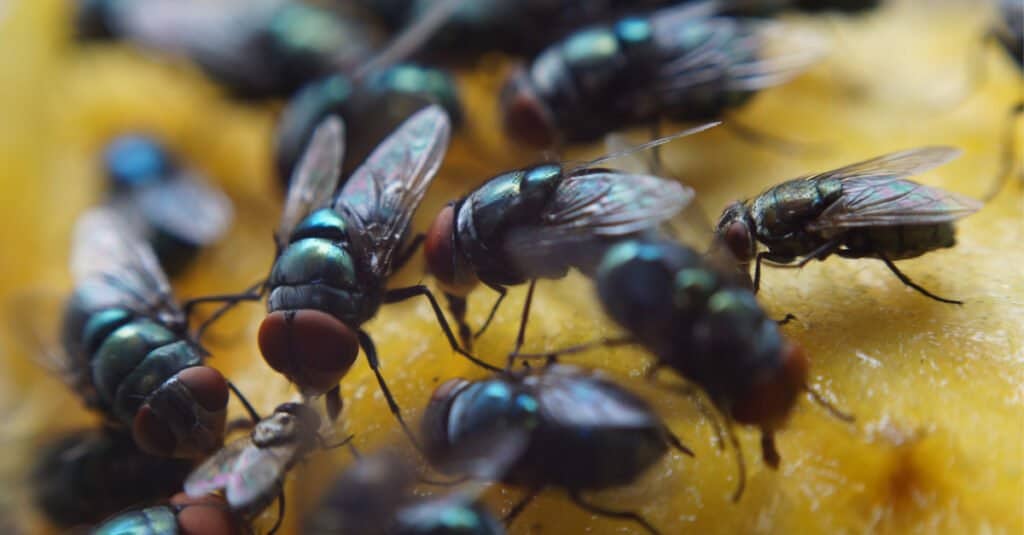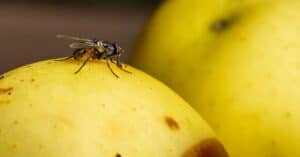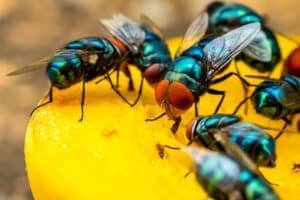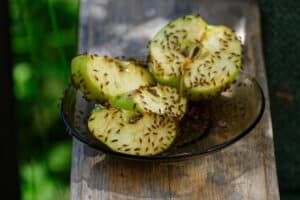Despite their annoyance to humans, flies are a fascinating insect with many unique biological features. Over 100,000 species of flies exist, many of which are not typically considered flies by humans. However, flies have piqued the interest of researchers for decades, leading to experiments and studies that help scientists understand other animals and the world around them. In fact, some fly research has aided in the better understanding of human behavior and activity. Discover whether flies are attracted to light and find out how light relates to their biology and to our own.

There are approximately 125,000 species of flies around the world.
©Mauricio Acosta Rojas/Shutterstock.com
Background on Flies
The term “fly” encompasses a myriad of insect species. Around 125,000 species of flies exist across the globe. The main characteristics of flies are one pair of wings for flight and a second pair of wings, often called knobs, which are used for balance. Diptera is the taxonomic order that describes insects belonging to the fly species. Some Diptera include mosquitoes, gnats, and true flies. Some true fly species are houseflies, horse flies, bees, and fruit flies. Other insect species are called flies, but they are not true flies. For instance, the dragonfly is not a true fly because its wing structure does not align with the characteristics of true flies.
The common housefly is most familiar to humans, as around 90% of flies that enter homes are houseflies. Houseflies have a dark gray coloration and measure between 0.2 and 0.3 inches in length. The eyes are likely the most fascinating feature on houseflies. Housefly eyes contain thousands of lenses, and they have compound eyes. Compound eyes allow houseflies to detect the polarization of light and a color spectrum that is not visible to the human eye. Compound eyes also help houseflies to detect slight movements within a wide field of vision. In this way, they can react quickly to movement, which is why humans often encounter trouble when attempting to catch or kill a housefly.
Houseflies are also able to latch onto vertical walls or hang from ceilings because of their unique biology. Glandular pads on housefly feet create a residue with surface tension properties that allows them to hang upside down or stick to surfaces. This behavior would otherwise be physically impossible for other animals or humans to accomplish. Furthermore, housefly feet carry an enormous amount of microorganisms, which can ultimately cause disease.

Houseflies have compound eyes which allow them to detect the polarization of light and a color spectrum that is not visible to the human eye.
©Fotopstryk/Shutterstock.com
Interesting Housefly Facts
Houseflies are a species with more surprising facts than one might believe. For instance, houseflies can’t eat solid food. Rather, they have a liquid diet. Houseflies are not equipped with the mouthparts necessary to chew food. Therefore, they must drink what they want to consume. Since many foods are solid, houseflies must turn their food to liquid to eat it.
Houseflies will regurgitate a digestive substance, which works to break down solid foods into smaller parts. After the food has been broken down, the proboscis, which is the housefly’s mouthpart, can slurp up the liquid food. However, flies actually taste food with their feet. Taste receptors are located on the feet and legs of the housefly. When flies land on food or feces, they will walk around, allowing them to taste the food. From that point, houseflies can begin to consume the food with their proboscis.
In addition, houseflies do not live for very long, approximately 30 days. While they don’t retain a long lifespan, they can lay hundreds if not a thousand eggs during their lifetime. The lifecycle of a fly is defined by several stages. It begins with eggs, which hatch after eight to 12 hours. The hatchlings begin their first larvae stage, followed by two more stages. The larvae eventually turn to pupa, and flies remain in this stage for around five days. Finally, the pupa become adult flies, which live for a few weeks and eventually die.

Taste receptors are located on the feet and legs of the housefly.
©iStock.com/reyborfrla
Are Flies Attracted to Light?
Flies are attracted to ultraviolet light. Ultraviolet, or UV, light is a kind of electromagnetic radiation. Electromagnetic radiation derives from the sun, and it is transmitted through waves and particles categorized by different wavelengths and frequencies. The electromagnetic spectrum contains seven categories, each of which are defined by a certain energy and frequency. UV light is one of these electromagnetic radiation categories, and UV light sits between visible light and X-rays on the electromagnetic spectrum.
Furthermore, UV light contains its own subcategories. These subcategories are UVA, UVB, and UVC. Each subcategory is defined by the measurements of its wavelengths. For instance, UVA has wavelengths from 315 nanometers to 400 nanometers. On the other hand, UVB has wavelengths from 280 nanometers to 315 nanometers, and UVC is between 180 and 280 nanometers. How does this relate to flies? Flies are most attracted UV light with wavelengths from 310 to 370 nanometers. In other words, flies prefer UVB or UVA light.
In addition, there is a correlation between the intensity of the UV light emitted and the number of flies attracted to this light. The greater the intensity, the more flies will be attracted to the UV light. This phenomenon occurs because flies are diurnal, meaning they are most active during the day when light is at its peak. Flies operate on a circadian rhythm, which describes a 24-hour cycle of increased and decreased activity. Circadian rhythm is found in many animals and in humans. We all operate on a biological clock, which determines when our body desires to rest or to be active. Flies operate in the same manner. Just as most humans are active during daylight because our circadian rhythm tells us to be, so are flies active when light intensity is at its peak.
How to Catch Flies with UV Light
Since flies are most attracted to UV light at greater intensities, UV light fly traps should have an open front. An open front on these traps allows UV light to be transmitted at a greater intensity, attracting more flies. However, UV light may not attract flies immediately, even at high intensities. It may take time for the flies to recognize the light, become attracted to it, and be caught. On the other hand, flies may become immediately attracted to the UV light and then lose interest. Flies lose interest in continuous brightness or UV light due to their circadian rhythm. When flies are exposed to continuous brightness, their circadian rhythm is suppressed, according to one study.
In one experiment, researchers found that when a UV light was turned on, flies rushed to the light immediately. Within a few minutes, all activity ceased. Then, the researchers turned off the lamp for five minutes. When they turned the lamp back on, the flies rushed toward the UV light once again and eventually lost interest after a short period. Thus, the best types of UV light traps for flies are those that emit a high intensity of UV light and those that can be turned on and off manually or automatically for certain intervals.
What Else Attracts Flies?
There are several things that attract flies and can bring them into the home. Furthermore, different types of flies are attracted to different things. For instance, house flies are most attracted to manure or pet feces as well as rotting meat. Fruit flies prefer sugar, causing them to go after spilled drinks, alcohol, or fruit that is overripe. Drain flies like wet, humid areas with organic materials. Drain flies are likely to lay eggs in the drains of kitchen sinks or tubs. Some other attractions of flies are open garbage cans, animal carcasses, and many types of food left out or uncovered, especially meat or sugary foods.

Garbage and leftover uncovered food can attract flies.
©iStock.com/PinyoJPR
Preventing Flies in the Home
Preventing flies is not a difficult task for the responsible homeowner. Removing trash regularly and keeping garbage cans covered are two of the best ways to keep flies out of the home. Furthermore, pet owners should clean litterboxes or pick up pet feces with frequency, as flies are highly attracted to manure and feces. Homeowners should not let food rot in the home, and they should regularly sanitize the garbage disposal to prevent drain flies. Finally, keeping windows and doors closed during the spring, summer, and fall keeps flies from invading the home, decreasing the possibility of infestation.
Thank you for reading! Have some feedback for us? Contact the AZ Animals editorial team.








